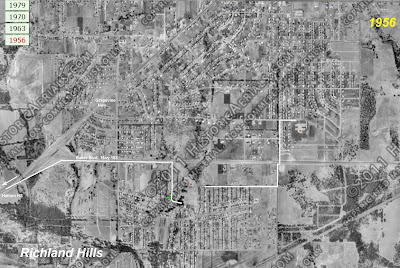The previous article explored the
development of the Ft. Worth Meadowbrook – Eastern Hills neighborhoods starting
with a 1920 map and looked at the changes in approximately 10-year increments
through 1971. One thing the study
revealed was that Meadowbrook was actually a rural setting
until not long before we entered EHHS in 1960.
Areas between EHHS and Meadowbrook
Junior High were sparsely settled in the 1950s, consisting of a mixture of
rural horse pastures and a few small housing developments. The housing developments appear to have been
done as modest undertakings, consisting of perhaps a block of 40-60 houses per
effort. Interspersed in this area are a
few much older homes that were built in the 1920-1940 period, generally
consisting of some attached acreage.
Most of the 1950s home construction activity was going on within the green circled areas. The red circle encloses the Meadowbrook - Eastern Hills subdivision which was a large undertaking, starting about 1953.
After WWII, one of the great American government programs of all time supported returning veterans through certain benefits under provisions of the GI Bill. Approximately 2 million of the 16 million eligible veterans went to college under the GI Bill and many more used the government GI mortgage guarantee to purchase their first homes. This sparked a building boom that lasted throughout the 1950s. In our area, many of the post-WWII homes built were GI homes, typically a 2 or 3-br, 1-bath, 1-garage layout.
Concurrently, just to the north of Meadowbrook, Richland Hills was building at an even greater rate. Essentially everything shown in the picture below was built after 1950...the two pictures used in this piece were taken from about 1200' and show the same land area. Richland High School opened in 1961, just 2-years after EH opened. My childhood was spent living about half the time in each place.
After WWII, one of the great American government programs of all time supported returning veterans through certain benefits under provisions of the GI Bill. Approximately 2 million of the 16 million eligible veterans went to college under the GI Bill and many more used the government GI mortgage guarantee to purchase their first homes. This sparked a building boom that lasted throughout the 1950s. In our area, many of the post-WWII homes built were GI homes, typically a 2 or 3-br, 1-bath, 1-garage layout.
Concurrently, just to the north of Meadowbrook, Richland Hills was building at an even greater rate. Essentially everything shown in the picture below was built after 1950...the two pictures used in this piece were taken from about 1200' and show the same land area. Richland High School opened in 1961, just 2-years after EH opened. My childhood was spent living about half the time in each place.


No comments:
Post a Comment